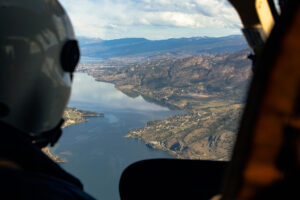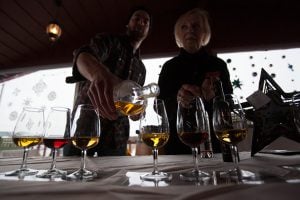
Travel
Exploring land art in Umbria, Italy’s green heart
From modern works of sculpture to remnants of ancient civilizations, Italy’s Umbria region is rich in cultural heritage
- 1114 words
- 5 minutes
Travel
Discover why Piedmont in northwestern Italy is a haven for gourmands

An expansive region of Italy bordering Switzerland and France, Piedmont has long been a favourite destination for gourmands thanks to its innovative food culture and reputation for quality. This tradition continues today, so consider one of the following eight itineraries for your next European taste trip.

Italy’s first capital city and today the beating heart of Piedmont, Turin has an innate creative energy. It was here that grissini (bread sticks), vermouth, gianduja (a rich chocolate-hazelnut spread) and unique ice cream flavours were born, and this rich gastronomic tradition is still expressed in the city’s many pastry shops and cafés, trattorias and Michelin-starred restaurants. Among the most popular and beloved snacks in Turin (and beyond) is the tramezzino. This tiny tea sandwich was invented by the owner of Turin’s Caffè Mulassano in 1926. Tradition has it that the godfather of this sandwich was a true celebrity, the poet Gabriele D’Annunzio. The little “hunger stopper,” as it was first called, thus found its definitive Italian name: tramezzino.
What about vermouth? Italy’s taste capital can also credibly claim to be the origin of this versatile aperitif. The ancient Romans had a similar drink called Absinthiatum vinum, which was passed down with the German name Wermuth (wormwood, or absinthe). In 1786, Antonio Benedetto Carpano replicated the recipe by mixing herbs and spices with Muscat wine from his cellar, which was located near the Royal Palace in Turin. Convinced that his concoction was a winner, he gave a cartload to King Victor Amadeus III, who was delighted with the drink and appointed Carpano official supplier of the Royal House. The rest, as they say, is history: vermouth is now regarded as an essential ingredient in the world of mixology. Read more stories of taste.

Nestled in the heart of the Cottian Alps, which form the border between France and Italy, Valle Grana has for centuries cultivated a reputation for excellence in food and wine. Visitors are drawn to the region’s architectural masterpieces, which frequently blend seamlessly with the breathtaking alpine landscape, such as the Santuario di San Magno, a 15th-century church built at over 1,700 metres of elevation, and the tiny hamlets (called frazioni) of Colletto in Castelmagno and Chalancho in Pradleves, which literally cling to the rocks. The “King of cheeses,” Castelmagno, was born in this place, where pastures seem to touch the sky. Made mainly with cow’s milk and aged for at least three months in cool, humid natural stone cellars, Castelmagno has been produced here since medieval times and is now a symbol for the entire valley. A must-try for gourmets is potato gnocchi coated in the beloved Castelmagno cheese, and be sure to look for local Madernassa pears, jams and craft liquors. Find out more: www.visitcuneese.it/en

You’ve no doubt heard of Lake Como, famously a lavish sanctuary for Hollywood (and actual) royalty, but just a short distance to the west lies one of Italy’s best-kept secrets: the lake district of Piedmont. Here, guests are invited to stroll through the vineyards of the Val d’Ossola, where tart, mid-bodied Valli Ossolane grapes are cultivated. Following ancient mule tracks, you can discover marvelous villages still well-preserved and showcasing typical rural architecture. Specialties of this region include the black bread of Coimo, made from rye; Ossola-style gnocchi; prosciutto crudo from the Vigezzo Valley, Brisaula Val d’Ossola (a cured meat prized for its delicate, sometimes spicy flavour) and the famous goat’s “violini.” Excellent cheeses include Ossolano, the prized Bettelmatt and Toma del Mottarone.
The lakes here are famous for their freshwater bounty: trout, perch and whitefish, pike, char, gardon and bleak. And for dessert, choose from between tasty lake shortcakes or a traditional Ossola-style bread and milk cake, cooked in a terracotta pan. Find out more: www.distrettolaghi.it/en

The province of Vercelli encompasses three types of landscapes in a very small area: the mountainous landscape of Valsesia, the hilly landscape of the lands between Gattinara, Roasio, Lozzolo, and Serravalle Sesia and the area around Moncrivello and the lowland landscape dominated by rice fields. This region is Europe’s largest rice producer, and opportunities abound for the curious to learn about the versatile grain from families that have cultivated and processed it for generations. Visitors can also sample superb rice-based dishes and specialties such as panissa, a typical risotto with beans, pork rinds, chopped lard, herbs and salam d’la duja.
Moving north, we reach the main wine-growing area located close to Gattinara in the Nebbiolo Lands of Northern Piedmont, just south of the Mount Rosa massif. This is the place to taste all manner of excellent wines, from the red Gattinara, Bramaterra and Lessona to Coste della Sesia and Canavese. The region’s farms, rice mills and wineries host guided tours and tastings by appointment. Find out more: https://visitvalsesiavercelli.it/en/

An unexpected natural jewel, nestled in the northwest of Piedmont, the Biellese is the ideal place to relax and rejuvenate with fine wine and food and luxury accommodations.
Visit Serra Hill, the longest moraine in Europe and the natural boundary between Biellese and Canavese. Stop to enjoy amazing views along its ridge before making your way to Lake Viverone. Here, many small winemakers show off their local wines, Erbaluce and Canavese.
In the hills of Eastern Biellese, discover the small historic villages of Masserano and Lessona and the wines produced at the nearby family-owned estates in this verdant area: Bramaterra, Lessona and Coste della Sesia, based on Nebbiolo vines. There’s an opportunity to stay in castles, like those in Vigliano and Castellengo, combining wine tasting and history while enjoying modern comforts and the tranquillity of the countryside.
Then, discover Oasi Zegna, a vast and freely accessible area (no gates, tickets or opening hours) that covers around 100 square kilometres with views of the Po Valley and the alpine peaks from Monte Rosa to Monviso. Here, in restaurants and mountain huts, you can enjoy an irresistible menu based on Piedmont traditions, featuring main dishes like meat stew and polenta, game with bilberries, butter and cheeses, goat salamis, mocetta (made with beef joist, spiced with mountain herbs), honey, and jams produced in Oasi Zegna (subject to availability). Find out more: www.atl.biella.it/en/home

The Novara area offers not only the pleasure of cultural and natural beauty, but also appeals to our sense of taste. The Monteregio (the ancient name for the Novara Hills) is a magnificent example of the range of food and drink that make up the Italian culinary tradition. The whole region can be discovered on foot or by bicycle through a variety of itineraries that lead visitors across beautiful landscapes dotted with vineyards and through villages rich in culture and art. While on the route, a taste of the wines of the area is mandatory, from the noble Ghemme to the Boca, Fara and Sizzano varietals. And because what’s a wine tasting without a charcuterie pairing, the Novara Hills are home to many producers specializing in cured meats like Salam d’la Duja (a typical salami matured in fat) and Fidighina (a soft mortadella made from liver.) Gorgonzola cheese is a staple, produced in the area of Prato Sesia. And for those who have a sweet tooth, there is also a wide choice of baked goods: from the Beatine (“blessed” biscuits) of Ghemme, which can be found in the historic Ricetto Castle, to the Baci (chocolate kisses) of Fara Novarese and the Busarola from Romagnano Sesia. Find out more: www.turismonovara.it/en/home

In the province of Alessandria in eastern Piedmont, more than 700 kilometres of roads connect 109 municipalities, passing through more than 20 varieties of wine. The Gran Monferrato Wine Route tells the story of a unique territory and its oenological heritage. The road, which joins the municipalities of Acqui Terme, Casale Monferrato and Ovada, is divided into four different sections and can be navigated via a number of itineraries. The first section is the Strada del Grignolino, which unites Casale Monferrato and Cuccaro in a 240-kilometre route. Then there is the Wine River Route, from Cuccaro to Castelnuovo Bormida (125 kilometres), the Strada degli Aromatici, from Castelnuovo Bormida to Morbello (231 kilometres), and, finally, the Strada del Dolcetto, which connects Cassinelle and Bosio (108 kilometres). You can travel by bicycle or car, stopping at wineries along the way to experience this area and its wines, including Brachetto d’Acqui, Acqui, Gavi or Ovada, or even the Dolcetto, the Grignolino or the Cortese. Find out more: www.granmonferrato.it

This tour unfolds amidst the rolling hills of Montferrat, starting from the Albugnano Regional Enoteca, where visitors can taste local wines produced in four villages in the northern Asti area (Albugnano, Castelnuovo Don Bosco, Passerano Marmorito and Pino d’Asti). Visit the Abbey of Vezzolano and don’t miss the essential gourmet stop at Cocconato d’Asti, one of the most beautiful villages in Italy. Here, in the centre of the village, you will find the “Latteria” in Piazza Cavour, famous for its robiola cheese, tomini and local butter. Once you leave the village, you will reach the Bava winery, where you can sample iconic wines and other regional specialties, including the historic vermouth of Turin, Barolo Chinato, Alta Langa brut and a selection of gourmet treats. Dessert is served in Moncalvo, “Italy’s smallest village,” which is synonymous with truffles and fat ox. Find out more: www.visitlmr.it/en
Are you passionate about Canadian geography?
You can support Canadian Geographic in 3 ways:

Travel
From modern works of sculpture to remnants of ancient civilizations, Italy’s Umbria region is rich in cultural heritage

Travel
A couple’s guide to taking in the wine, food and unique desert scenery of Osoyoos

Travel
The holidays may be over, but January can still be a time of celebration by bundling up and heading to the Niagara Icewine Festival

People & Culture
The world has a lot of wine. Here's part of what makes Canada's product so special